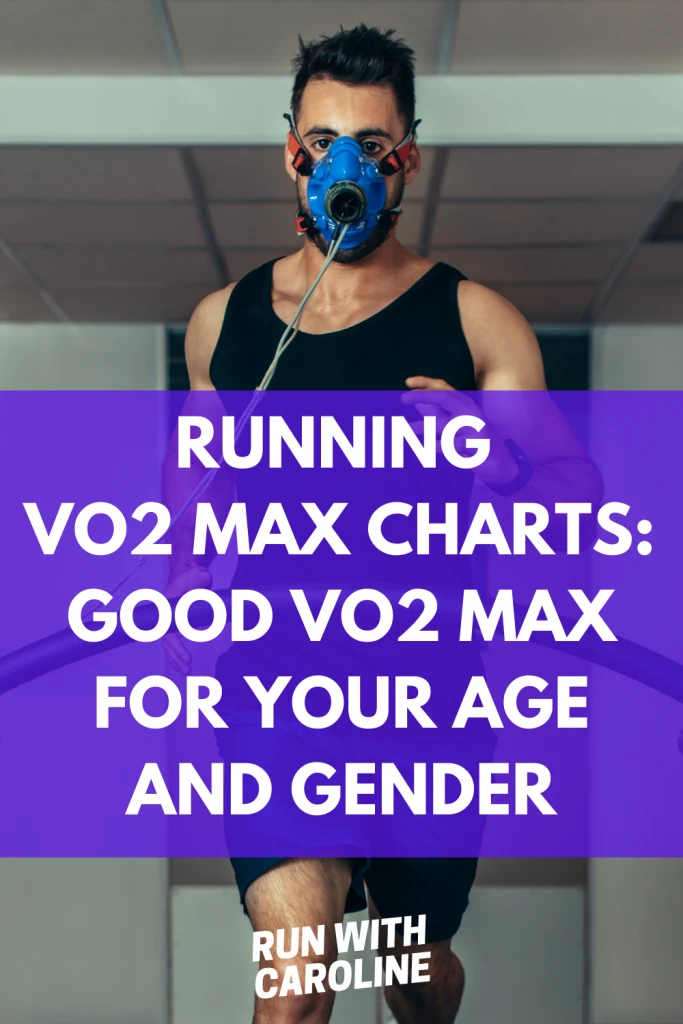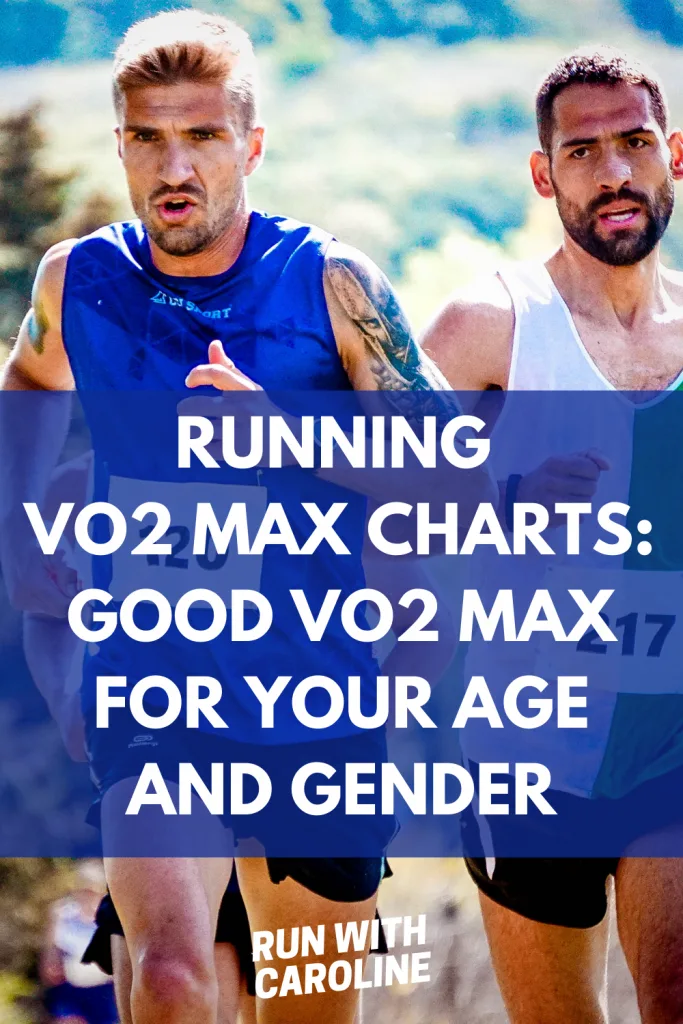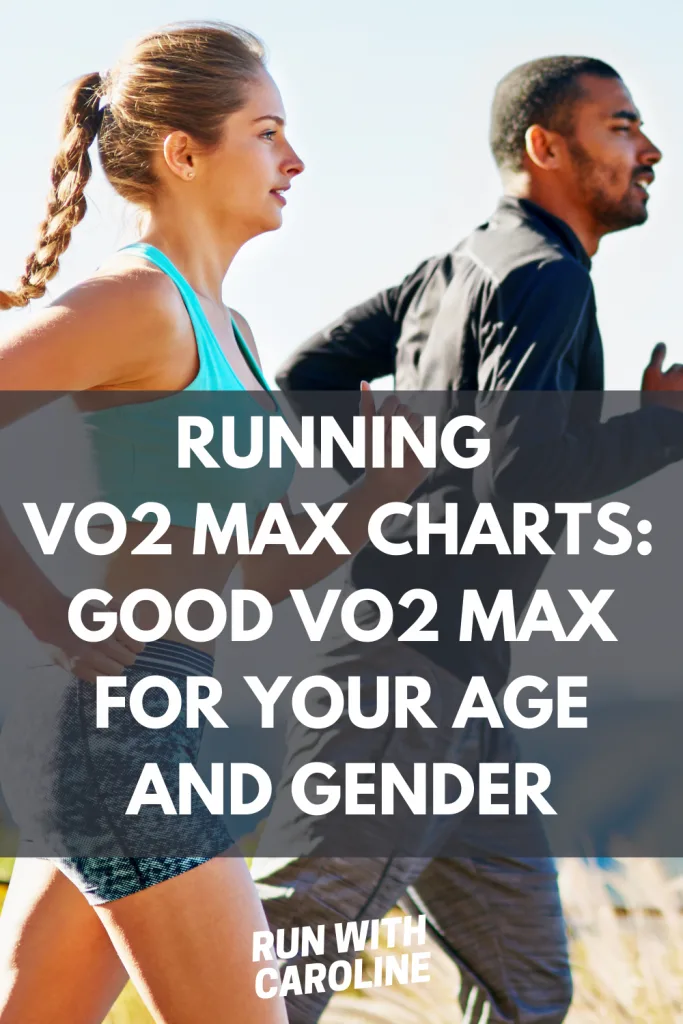There are many ways to track your fitness levels – from heart rate to calories burned to steps walked to miles run.
Many of these fitness markers can be tracked and measured using a GPS running watch or running app.
However, there’s one fitness marker that cannot be measured using your watch or a running app: your VO2 Max.
One good way to measure your VO2 Max is using running VO2 Max charts.
Running VO2 Max charts are really helpful tools to measure your aerobic endurance.
But what exactly is VO2 Max, why is it important and what is it used for in running?
In this guide we’ll explore:
- What is VO2 Max?
- Why VO2 Max is important for runners
- How to calculate VO2 Max
- What is good VO2 Max by age and gender?
- Running VO2 Max charts for your age and gender
- How to increase VO2 Max
- Sample VO2 Max workouts
Ready?
Let’s get going!

What is VO2 Max?
VO2 Max (also known as aerobic capacity) is the maximum rate of oxygen your body is able to consume during exercise.
Although the term VO2 Max sounds complex, it’s actually very simple. The term VO2 max stands for:
- Volume (V)
- Oxygen (O2)
- Maximum (Max)
It is a measurement commonly used as a predictor for athletic performance in sports like running, cycling and swimming.
The greater your VO2 Max, the more oxygen your body can consume, the more effectively your body can use this oxygen to generate the maximum amount of energy needed for exercise.
Related: How to increase your running stamina and endurance
Why is VO2 Max important for runners?
VO2 Max is important for a number of reasons.
Namely because it determines your oxygen capacity and subsequently your capacity for exercise and endurance activities like running.
Essentially, the higher the volume of oxygen you are able to use, the higher your capacity for exercise and endurance activities like running.
VO2 Max is also a great way to determine and track your performance.
By measuring your VO2 Max at the start of your training cycle and comparing it to your VO2 Max at the end of your training cycle, you can measure improvements.
Related: 8 ways to run for longer without getting so tired

Related: Heart rate when running: The complete guide
How to calculate VO2 Max
The most reliable way to calculate your VO2 Max is in a lab or gym, but as many runners don’t regularly have access to these facilities, there is a simpler way to estimate your VO2 levels.
I recommend using a VO2 Max calculator. To use the calculator effectively you will need to know:
- Recent race distance (in miles or kilometres)
- Recent race time
Enter these stats into the calculator and it will tell you your estimated VO2 levels. For example, if you enter a 10k race time of 47 minutes, here are your VO2 levels:
- VO2 Max – 43.02 ml/kg/min
- VO2 based on your race pace – 38.89 ml/kg/min
- Equal to 90.2% of VO2 Max
Related: Hydration and running performance
What is good VO2 Max?
Now you know your estimated VO2 levels, you may be wondering what is good VO2 Max.
Good VO2 Max varies from person to person.
This is because VO2 Max is influenced by a number of factors, including your genetics, gender, age, training style and training elevation.
You cannot control your genetics, gender and age.
But you can control your training style, (such as the quantity and quality of training sessions) and training elevation (such as exercise at sea level or higher up in the mountains).
Therefore, how, where and when you train provides you with the ability to improve your aerobic capacity.
It’s worth noting that as with a lot of things in running, there’s no one good VO2 Max level that every runner should aim for.
See the running VO2 Max charts below to see good VO2 levels according to age and fitness.
Related: How to run faster for longer: 5 top training secrets

Running VO2 Max charts: What is good VO2 Max for my age and gender?
The below running VO2 Max charts show VO2 Max norms for men and women levels ranging from poor to excellent according to age and gender.
| Gender | Age | Poor | Fair | Average | Good | Excellent |
| Men | Under 29 | < 24.9 | 25-33.9 | 34-43.9 | 44-52.9 | Over 53 |
| 30-39 | < 22.9 | 23-30.9 | 31-41.9 | 42.49.9 | Over 50 | |
| 40-49 | < 19.9 | 20-26.9 | 27-38.9 | 39.44.9 | Over 45 | |
| 50-59 | < 17.9 | 18-24.9 | 25-37.9 | 38.42.9 | Over 43 | |
| 60-69 | < 15.9 | 16-22.9 | 23-35.9 | 36-40.9 | Over 41 | |
| Women | Under 29 | < 23.9 | 24-30.9 | 31-38.9 | 39-48.9 | Over 49 |
| 30-39 | < 19.9 | 20-27.9 | 28-36.9 | 37.44.9 | Over 45 | |
| 40-49 | < 16.9 | 17-24.9 | 25-34.9 | 35-41.9 | Over 42 | |
| 50-59 | < 14.9 | 15-21.9 | 22-33.9 | 34-39.9 | Over 40 | |
| 60-69 | < 12.9 | 13-20.9 | 21-32.9 | 33-36.9 | Over 37 |
How to increase your VO2 Max
Now you know the average VO2 level for your age and gender, let’s look at the ways you can improve your VO2 Max.
Typically, VO2 Max decreases with age. However, there’s plenty you can do to maintain your VO2 Max levels.
The following workouts have been shown to increase VO2 Max:
- High intensity interval training (HIIT)
- Multiple aerobic activities in a single workout (e.g. running, cycling and swimming workouts)
The bottom line? You should be doing high intensity workouts (such as interval training, tempo running, Fartlek training) alongside switching up your aerobic activity to really see benefits when it comes to your VO2 Max levels.
Related: Cross training tips for runners

Sample V02 Max workouts for runners
Here is a range of sample VO2 Max workout for runners depending on the race distance you are training for.
Ideal for 5k and 10k runners: interval training
- 4 x 3 minute intervals at 5k race pace, with a recovery jog in between
- 5 x 2 minute intervals at 5k race pace, with a recovery jog in between
Ideal for half marathon and marathon runners: tempo running
- 20 minute easy run, 10 minute tempo run, 20 minute easy run
- 10 minute tempo run, 3 minute jog, 10 minute tempo run
Ideal for trail runners: Fartlek training
- 8-7-6-5-4-3-2-1 minute Fartlek run, starting at tempo effort and increasing to VO2 Max effort for the last few minutes. Take a recovery jog in between the first five intervals.
Related: 11 Fartlek training advantages and disadvantages
More running tips:
- 5 things I wish I’d known before returning to running - March 3, 2024
- Running 20 minutes a day: Benefits + how to start - January 27, 2024
- How to run your first 2 hour half marathon - January 16, 2024

John Quiggin
Wednesday 17th of May 2023
Any thoughts on what is going on here? And thanks for the site, very clear and informative
John Quiggin
Wednesday 17th of May 2023
I have a problem reconciling the running times with the VO2 max norms. Taking your example of a 10k race time of 47 minutes, you get a VO2 max of 43, which is listed as "average" for M20-29. But looking at race results for the Bridge to Brisbane race (mass participation with about 40000 runners), a time of 47 minutes would get a category placing of 190 for age group M25-29, out of several thousand competitors. And of course, these are only the people who entered the event. If I had to guess, I'd say the average man in his 20s would take more than an hour to run 10k
Stephen
Sunday 8th of May 2022
An excellent site, full of useful info.
I’m representative of a generation of ex joggers who are now retired from work, and after a 27 year break (or similar that’s my figure) - are now getting back into running. I and many others are looking for a 10k programme to help get under 60 mins. I’ve managed 67 mins last year, must try harder….
Caroline Geoghegan
Saturday 2nd of July 2022
Hi Stephen. I'm delighted to hear that you're getting back into running - it never is too late! How are you getting on with your training? 67 minutes is still a very good time!